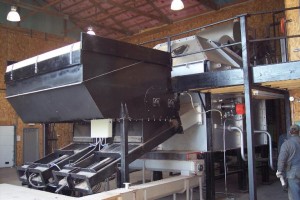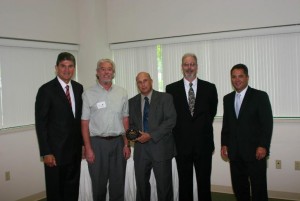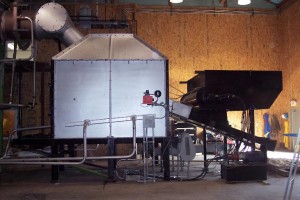
Carterville test facility showing gasifier in the background with hydraulic rams and fuel bin (feed system) in foreground
Gasification is a chemical reaction caused by heating material in an oxygen-starved environment, resulting in incomplete combustion that drives off carbon-rich gases. These gasses are then combusted in a thermal oxidizer with the addition of air. Gasification is often confused with incineration, although they are totally different processes. Incineration is the actual combustion or burning of solid fuels, which takes place at higher temperatures, combusts the material completely, and does not produce a carbon-rich biochar.
The main component of Coaltec’s gasification technology is a fixed-bed gasifier. This patented design is generations ahead of wood-fueled systems and is engineered to support a variety of fuels, including manures and other biomass. The commercial-scale test facility, as well as the experience that Coaltec has gained over time working with a wide variety of fuels and operating parameters, sets them apart in the industry. This experience has led to the development of a new and improved patented design. The ability to control the operating parameters of the technology allows them to formulate various grades of biochar, which offers significant economic and environmental value to projects. The gasification process takes place in the primary unit, in an oxygen-starved environment, thus controlling nitrous oxide (NOx) formation. The low-pressure system allows for gasification with no or minimal carryover of particulate matter from most fuels. The main product of gasification is carbon monoxide (CO), with some hydrogen and methane gases.
Temperature control and retention time are critical in the quality of the biochar being made, and these factors may vary depending on its application. In instances when a formulated biochar is produced, a low fuel bed temperature is specified. For projects when there is a need to minimize the carbon in the ash, a longer retention time is needed to react a portion of the fixed carbon.
The syngas composition is fuel dependent, with temperatures typically ranging between 1000- 1400 degrees F. Once the syngas leaves the gasifier and flows into the oxidizer, ambient temperature air is introduced to combust the syngas, with the CO being converted to carbon dioxide (CO2). The combustion process produces a gas stream of about 1800 to 2000 degrees F. Because of the low BTU value of the syngas and the expense involved in potential clean up, this technology does not produce a gas that is economically feasible to take directly from the gasifier and convert to a liquid fuel – with the commercially available, proven technologies that Coaltec has seen to date.
The ability to use the thermal energy product as direct heat, steam, or electricity is a simple matter of adding equipment. The modular design makes construction quick and relatively easy, and the addition of components is comparatively simple.
An advantage of this technology as compared to alternatives is the acceptable range of variations in quality and varieties of fuels. The system will easily operate with fuels containing 4,000 BTU/pound, and has operated with fuels containing more than 60% moisture, though we normally target fuels in the 15-20% range. The gasifier fuel feed and ash removal systems allow for the use of fuels with up to 4 inch particle size.
The system is web-based remote controlled, allowing off-site operation of the system if desired. This provides tremendous flexibility and oversight to the owner and the ability for real-time troubleshooting which can eliminate downtime. The system has PLC controls which can be interfaced to most existing systems, and provides a wide range of flexibility in operating parameters and the ability to control the system to provide the proper amount of energy for the customer’s needs – both when and where they need it.
In 2002, Coaltec developed and installed a gasifier as a demonstration and test system at their facility at Carterville, Illinois. A new gasifier with design improvements was installed in November 2006. The purpose of the facility is to test new fuels, or combinations of fuels, at a commercial scale. The test system has a significant amount of monitoring equipment to track performance during testing and is ported to allow for third-party emissions testing. Once a test is concluded, the emissions, heat rate, ash composition, and any operational issues created by specific fuels are identified. A heat and materials balance is completed which allows for an economic evaluation of the system and helps to identify the best options for a specific project. Data from the testing is used to design a system best adapted to the fuel(s) tested.
Gasification provides an array of benefits. These include:
- The ability to turn by-products and out-of-spec materials into revenue streams
- Reducing or eliminating costs now associated with non-product material disposal
- Formulating various grades of Biochar from a variety of fuel sources, with those from animal manures having especially high value
- Greater potential for sale of by-products in more stable form
- Significant reduction of mass of original material decreases transportation costs
- Control over energy production
- Freedom from escalating energy prices and foreign control
- Destruction of odors as part of the gasification process
- Meeting regulatory requirements with an alternative solution
- Halting the release of non-beneficial nutrients to waterways as a result of runoff from farm fields and storage piles
- Protection for a community’s economy that depends on clean air and water
Advantages of Coaltec’s Commercial-Scale Testing Over Bench-Scale or Laboratory Testing:
Coaltec’s commercial-scale demonstration and testing facility provides a platform for full-scale test firing of fuels and discovery of real world conditions and difficulties associated with the chosen fuel. Each test firing is a multi-day event from which data, including emissions, heat rate, and ash analysis, are compiled. Obstacles are often revealed which are not normally indicated at the desktop or laboratory scale. These can include fuel feed to the gasifier, moisture issues, contaminant problems, and fuel-specific mass volume handling requirements.
During testing, the gasifier will consume as much as 100 tons of material, unlike a few pounds an hour in a laboratory test. The length of test for each fuel or combination of fuels can range from 48 hours to several days and will determine:
- Optimal throughput and operating parameters to maximize the fuel and produce the most valuable biochar or, in instances when the ash will be landfilled, to provide the greatest reduction of volume
- Problems specific to the fuel such as clinkering, etc.
- The effects a sustained operation of the fuel may have on the gasifier
Conducting test firing at Coaltec’s commercially-sized demonstration unit in Carterville provides the critical data needed to determine outputs based on the specific fuel, fuels, or combinations of fuels, and to assure correct system design engineering.

